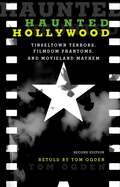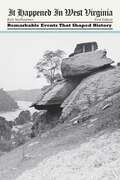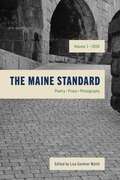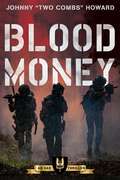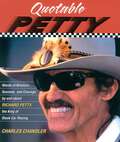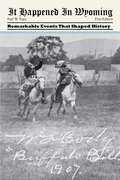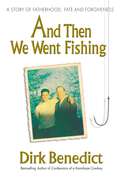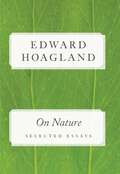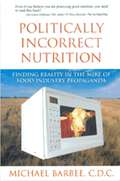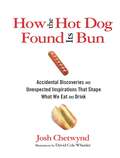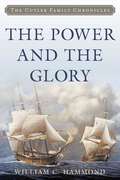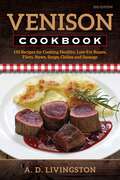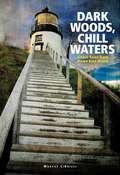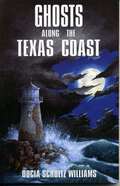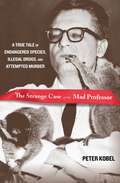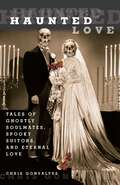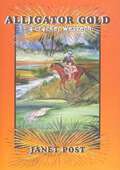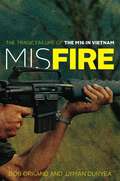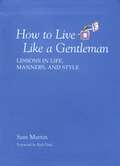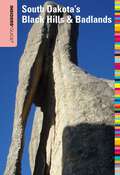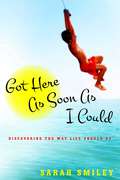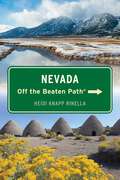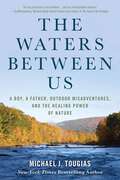- Table View
- List View
Haunted Hollywood: Tinseltown Terrors, Filmdom Phantoms, and Movieland Mayhem (Haunted)
by Tom OgdenHaunted Hollywood, a collection of stories of ghosts, mysteries, and paranormal happenings in Tinsel Town, will leave readers delightfully frightened. Each story includes notes on historical significance and local lore and readers will discover just how haunted and spooky their city is. A bibliography, a resources list of contact information to visit the haunted sites, and a brief &“Ghost Hunter&’s Guide&” for the region or city, are also included, giving readers the resources to explore the haunted areas for themselves.
Our Favorite Pasta Recipes Cookbook: Over 60 of Our Favorite Pasta Recipes, with Handy Tips!
by Gooseberry PatchSame great content, new photographed cover! With over 60 delicious dishes and as many time-saving tips, Our Favorite Pasta Recipes comes in a convenient purse-perfect size that's easy to take along for meal planning on the go. You'll love recipes for Family Night Noodle Bake, Mom's Lasagna Rolls and One-Dish Macaroni & Cheese. Durable softcover cookbook, 128 pages.
It Happened in West Virginia (It Happened In Series)
by Rick SteelhammerIt Happened in West Virginia takes readers on a rollicking, behind-the-scenes look at some of the characters and episodes from the Mountain State's storied past. Including both famous tales, and famous names--and little-known heroes, heroines, and happenings.
The Maine Standard Vol. 1: Poetry, Prose, Photography
by Liza Gardner WalshMaine has always been steeped in ingenuity and boldness. Perhaps it is the mix of granite coast and balsam breezes that gives rise to this inspiration, but whatever it is, the state has long held an abundance of world-class writers and artists. Honoring this deep tradition of great writing, The Maine Standard is an annual journal celebrating the uniqueness of Maine, the unusual and the unexpected. Perhaps our founder Duane Doolittle said it best: &“We don&’t pretend that we can define this evocative term, Down East . . . All that we can honestly say is that we are tuned to this particular parcel of land, and that we like its music.&” The Maine Standard publishes stand-out writing that captures the true character of Maine, writing that sings!
Blood Money: An SAS Thriller
by Johnny "Two HowardBoat Troop are sent upriver into Sierra Leone on a mission to secure a vital ore mine. While the men battle their way past vicious hippos and poisonous snakes, political events are rapidly overtaking the city-based HQ. As the balance of power swings between government and rebels, HMG wavers in its intentions. Soon after Boat Troop arrive at the mine, they discover they are on their own and now have the extra burden of civilians to hamper their task.
Quotable Petty: Words of Wisdom, Success, and Courage, By and About Richard Petty, the King of Stock-Car Racing
by Charles ChandlerPetty's savvy promotional and media persona has helped make him one of America's most quoted sports champions.
It Happened in Wyoming (It Happened In Series)
by Paul W. PapaIt Happened in Wyoming takes readers on a rollicking, behind-the-scenes look at some of the characters and episodes from the Equality State's storied past. Including both famous tales, and famous names--and little-known heroes, heroines, and happenings.
And Then We Went Fishing
by Dirk BenedictFrom actor Dirk Benedict comes this brilliant autobiographical telling of two unique and engrossing events that had an enormous impact on his life. He intertwines the story of his wife&’s unexpectedly complicated home birthing with his own coming of age in Montana—and the violent death of his father. Past events of love, friendship, hatred, and fatherhood culminate in a dramatic explosion before him, linking his father&’s death with the birth of his first child. Benedict&’s writing style is lively, creative, and always engaging. His use of humor, pathos, and imagery is masterful. He has taken two rites of passage in his life and woven them together to produce a story that is every bit as entertaining as it is moving. Given Dirk&’s unique storytelling ability and well-honed sense of timing, And Then We Went Fishing will keep you hooked from page one to its powerful, poignant conclusion.
On Nature: Selected Essays
by Edward HoaglandAnnie Dillard observes "The best of Edward Hoagland is the best in the land." Now, in a beautiful new hardcover edition, signed by the author, and including new material, comes the best observations on nature by the finest essayist of our time.
Politically Incorrect Nutrition
by Michael BarbeeDid you know that some noncaloric artificial sweeteners can actually make you fat—or even kill you? Did you know that the overconsumption of certain soy products can upset your hormonal balance and lead to hypothyroidism? Most people didn&’t, until now. Politically Incorrect Nutrition exposes many current and widely held beliefs foisted on both consumers and health-care practitioners by well-oiled, agenda-driven food industry propaganda. It analyzes popular claims and reveals what, in fact, is healthy—and what is decidedly unhealthy—by exploring the most current and objective scientific data regarding good nutrition.If you want to provide the best possible food for yourself and your family, or if you simply want to learn the truth behind the many food myths that are presented to us day after day, Politically Incorrect Nutrition is must reading.
How the Hot Dog Found Its Bun: Accidental Discoveries and Unexpected Inspirations That Shape What We Eat and Drink
by Josh ChetwyndSometimes it&’s neither art nor science that serves as the origins of the everyday kitchen and food items that we take for granted today. Sometimes, as Josh Chetwynd shows us in How the Hot Dog Found Its Bun, some of our greatest culinary achievements were simply by-products of &“damned good luck.&” In How the Hot Dog Found Its Bun, Josh explores the origins of kitchen inventions, products, and foodstuff in seventy-five short essays that dispel popular myths and draw lines between food facts and food fiction. Josh&’s charming text combined with simple line illustrations makes this an excellent gift and go-to source book for all food and trivia buffs.
The Power and the Glory (Cutler Family Chronicles)
by William C. HammondThe Power and the Glory is the third novel in the historical, nautical fiction series from William C. Hammond. It follows in the wake of A Matter of Honor and For Love of Country, and features the adventures of the seafaring Cutler family of Hingham, Massachusetts, and an ever expanding cast of characters. Set during the Quasi-War against the French Republic during the late 1790s, The Power and the Glory offers the reader a stirring and authentic look at the birth of the modern United States Navy during the Age of Fighting Sail. Whether confronting French pirates off the coast of Nantucket or heavily armed French frigates in the Caribbean, Capt. Thomas Truxtun, Capt. Silas Talbot, Lt. Richard Cutler, and other early naval heroes—most real, some fictional—personify the best of American honor and courage. Beyond electrifying sea battles and the challenge to French colonial rule in Haiti and in the French West Indies, The Power and the Glory provides intriguing glimpses into everyday life of the era, be they in the bedroom of the Cutler clapboard home in Hingham, on the island of Barbados where the Cutlers own a sugar cane plantation and run a far-reaching commercial enterprise, or aboard Adm. Sir Hyde Parker's flagship in Port Royal, Jamaica. And at the center of all the excitement, passion, and intrigue are two of the finest "super frigates" ever constructed: USS Constellation and her sister ship, USS Constitution. As with all books in the series, the author's careful research and attention to detail, coupled with his thorough knowledge of sailing and the ways of the sea, bring history alive in a refreshing and entertaining fashion.
Venison Cookbook: 150 Recipes for Cooking Healthy, Low-Fat Roasts, Filets, Stews, Soups, Chilies and Sausage
by A. D. Livingston"A.D. knows how to cook venison." --Gray's Sporting JournalPresents 150 ways to prepare this healthy, versatile, low-fat meatLearn techniques to cook roasts, filets, stews, soups, chili, sausageRecipes for traditional American fare and international dishesBlackened Venison, Montana Venison Loaf, Easy All-American Chili
Dark Woods, Chill Waters: Ghost Tales from Down East Maine
by Marcus LiBrizziForgotten somewhere between Bar Harbor, Maine, and New Brunswick, Canada, lies the most remote and mysterious section of the Eastern Seaboard. It is a region rich in stark beauty—and supernatural lore. The harsh landscape, with its rocky seaside cliffs and thundering surf and miles of dark, mysterious forest farther inland, lends itself to the ghost story. Overlaying the ghost tales gathered in this book is a sense of unspeakable horror and malice.
Ghosts Along the Texas Coast
by Docia Schultz WilliamsA collection of strange occurences, this book brings to light tangible evidence and first-hand testimony to validate a wide range of ghostly tales. Whether they haunt the place of their death or a place they loved in their lives, these spirits are found up and down the Texas coast. Author Docia Williams brings us the best of these stories, where they happen, and provides some of the history surrounding these spooky spots.
Strange Case of the Mad Professor: A True Tale of Endangered Species, Illegal Drugs, and Attempted Murder
by Peter KobelIt was one of the biggest scandals in New York University history. Professor John Buettner-Janusch, chair of the Anthropology Department, was convicted of manufacturing LSD and Quaaludes in his campus laboratory. He claimed the drugs were for an animal behavior experiment, but the jury found otherwise. B-J, as he was known, served two years in prison before being paroled, emerging to find his life and career in shambles. Four years later, he sought revenge by trying to kill the sentencing judge and others with poisoned Valentine’s Day chocolates. After pleading guilty to attempted murder, he was sentenced to twenty years in prison, where he died in mysterious circumstances. But before he was infamous at NYU, B-J, a scientific luminary, had also taught at Yale and Duke. One of the world’s foremost authorities on lemurs, our distant primate relatives on the remote island of Madagascar, he brought international attention to these endearing and endangered creatures. He cofounded the Duke Lemur Center in North Carolina and inspired a whole generation of scientists to study them and conservationists to save them and their habitat. His trials captured national headlines, but the mad scientist’s full story has never been told—until now.
Haunted Love: Tales of Ghostly Soulmates, Spooky Suitors, and Eternal Love (Haunted)
by Chris GonsalvesRomance is undeniably otherworldly. Heart racing, breath quickening, senses ablaze—it&’s all part of what makes love so frighteningly grand. As Francois de La Rouchefoucauld said four centuries ago, &“It is with true love as it is with ghosts; everyone talks about it, but few have seen it.&” And yet, there are those who have seen both. Welcome to Haunted Love.With settings ranging from southern Florida to South Korea, Haunted Love delivers a rich and varied collection of tales that touch the heart and tingle the spine. The book features lush historical narratives that capture all of the tenderness, heartbreak, and raw emotion of the love affairs along with the chillingly detailed encounters with the ghosts these ill-fated romances left behind.
Alligator Gold (Cracker Western)
by Janet PostCracker Westerns are rip-roarin, action-packed, can't-put-'em-down tales set in the frontier days of Florida. They are full of adventure, real heroes, and vivid, authentic details that bring Florida's history to life.With enough shoot-outs and stampedes for any good Western story, Alligator Gold adds its unique Florida twist with an alligator in a deep blue spring.The Civil War is over and Caleb Hawkins is finally on his way home from a Northern prisoner-of-war camp. Hawk's been trying to get his mind off giving the rotten Snake Barber part of the secret to finding his family's hidden cache of gold when he was delirious with malaria at the camp. Now he's focused on getting back to the D-Wing, his Florida cattle ranch, and Travis, his only son. But his code of honor intervenes when he encounters a very pregnant Madelaine Wilkes along the trail. Hawk is duty-bound to help her, which comes to include taking her home with him. What he learns about the father of her baby tarnishes his clear attraction to her. Maddy Wilkes has her own code of honor, which gets in the way of her strong attraction to Hawk. And Snake Barber's singular lack of moral code gets in the way of any normal life on the D-Wing.See all of the books in this series
Misfire: The Tragic Failure of the M16 in Vietnam
by Bob Orkand Lyman DuryeaThe M16 rifle is one of the world&’s most famous firearms, iconic as the American weapon of the Vietnam War—and, indeed, as the U.S. military&’s standard service rifle until only a few years ago. But the story of the M16 in Vietnam is anything but a success story. In the early years of the war, the U.S. military had a problem: its primary infantry rifle, the M14, couldn&’t stand up to the enemy&’s AK-47s. The search was on for a replacement that was lighter weight, more durable, and more lethal than the M14. After tests (some of which the new rifle had failed) and debates (more than a few rooted in the army brass&’s resistance to change), Secretary of Defense Robert McNamara ordered the adoption of the M16, which was rushed through production and rushed to Vietnam, reaching troops&’ hands in early 1965.Problems appeared immediately. Soldiers were often not adequately trained to maintain the new rifle (in fact some were told the new rifle was &“self-cleaning&”), nor were they always given cleaning supplies or instructions. The harsh jungle climate corroded the rifle&’s chamber, exacerbated by the manufacturer&’s decision against chrome-plating the chamber. The ammunition that accompanied the rifles sent to Vietnam was incompatible with the M16 and was the principal cause of the failure to extract malfunctions. The result was the M16 often jammed, making the rifle &“about as effective as a muzzleloader,&” in the words of one officer. Men were killed in combat because they couldn&’t return fire until the malfunction was cleared. Congress investigated and the rifle and its ammunition were incrementally modified, greatly improving its reliability over the next few years. Troop training was also improved. But the damage to the M16&’s reputation could not be undone, and many soldiers remained deeply skeptical of their rifle through the war&’s end.Misfire combines insider knowledge of U.S. Army weapons development with firsthand combat experience in Vietnam to tell the story of the M16 in Vietnam. Even as it details the behind-the-scenes development, tests, and debates that brought this rifle into service, the book also describes men and M16s in action on the battlefield, never losing sight of the soldiers who carried M16s in the jungles of Vietnam and all too often suffered the consequences of decisions they had nothing to do with.
How to Live Like a Gentleman: Lessons in Life, Manners, and Style
by Sam MartinToday, young men need etiquette guidance more than ever! And men&’s magazines such as Maxim and Esquire don&’t cover the array of potentially awkward moments. This little guide offers the last word on walking, talking, dressing, as well as:• shaking hands• tipping• tying a bow tie• small talk• fashion do&’s and don&’ts
Insiders' Guide® to South Dakota's Black Hills & Badlands (Insiders' Guide Series)
by T. D. Griffith Nyla GriffithYour Travel Destination. Your Home. Your Home-To-Be.South Dakota&’s Black Hills & Badlands Ghost towns and modern towns. Trendy eateries and rustic bars. Cowboys and artists. Rodeos, skiing, hiking, and biking. Breathtaking landscapes in a place of welcoming smiles. • A personal, practical perspective for travelers and residents alike• Comprehensive listings of attractions, restaurants, and accommodations• How to live & thrive in the area—from recreation to relocation• Countless details on shopping, arts & entertainment, and children&’s activities
Untwisted: How to Use the Power of Love to Heal Your Emotional Pain
by Dr. Ted AndersIt&’s no secret that life can be hard. The emotional pain that comes with being human is often met with sadness, depression, loneliness, anger, or even rage. These reactions lead to more pain, and so a cycle of negativity is created. These days there is no shortage of pharmaceuticals being recommended to alleviate this type of suffering, but most of these drugs have potential side effects that could be worse than the problems themselves. And what's more, they address only the symptoms of emotional pain, not the pain itself. Untwisted offers a different perspective on the subject and presents a unique step-by-step approach to breaking this cycle for good.Most of us go about our days under the delusion that happiness and fulfillment are feelings we need to search for in the outside world. This is twisted thinking. This bookreveals that these concepts are not found beyond ourselves but rather lie within, and that we may achieve them by remembering a truth that has been with each and every one of us all along. Untwistedwill guide you back to this truth and, in doing so, heal your emotional pain and bring you back to joy, your natural state.Untwisted proposes a proven drug-free technique you can use to eliminate the root cause of your emotional wounds and transform your life for the better. By following the simple but powerful practices described in this book, you may begin to untangle yourself from the sadness, loneliness, depression, and anger that have had you feeling tied up for so long.
Got Here As Soon As I Could: Discovering the Way Life Should Be
by Sarah SmileyI&’m not from Maine… but I got here as soon as I could. Six years ago, a family from Florida fell in love with &“the way life should be,&” and althoughthey&’ve never seen a moose, the Smileys intend to stay. Because say what you will about the coldwinters and the messy mud season, there is no other place to raise a kid than in the great state ofMaine.Got Here As Soon As I Could is a collection of syndicated columnist Sarah Smiley&’smost-loved columns about raising a family in Maine. In these 100 essays, readers will laugh, cryand nod their head &“yes&” as they remember a time when all of America was as simple and beautiful as it still is today in Vacationland.
Nevada Off the Beaten Path® (Off the Beaten Path Series)
by Heidi Knapp RinellaTired of the same old tourist traps? Take the road less traveled and uncover the hidden attractions, unique finds, and unusual locales other guidebooks just don't offer. Off the Beaten Path® features the things you'd want to see―if only you knew about them! From the best in local dining to quirky cultural tidbits, you'll say over and over again: &“I didn't know that!&”Discover a different side of the Silver State. Pose with the legendary Great Stone Mother near Pyramid Lake; experience breathtaking views of Carson Valley in a Lake Tahoe Balloon; or embrace your inner archeologist with a visit to the sandstone formations and ancient petroglyphs of the Valley of Fire. So if you've &“been there, done that&” one too many times, get off the main road and venture Off the Beaten Path.
The Waters Between Us: A Boy, a Father, Outdoor Misadventures, and the Healing Power of Nature
by Michael J. TougiasUntamed. Unsupervised. Uncontrolled.Boyhood in the 1960s and &‘70s was a time for exploration and mischief. Author Michael Tougias found more than his share of misadventures in the woods and on the water: some life-threatening but others innocently hilarious.Over time – and after reading a multitude of adventure books -- these experiences took shape in his quest to be a mountain man, owning a cabin in the forest and living off the land. Part of that dream would come true, but only after a family tragedy that shook his world and forced changes in his life.This is also a story of a complex and strained relationship between father and son, the efforts at understanding, and ultimately respect and devotion.In The Waters Between Us Tougias channels Bryson&’s &“A Walk in the Woods&” to mix laugh out loud humor with insight into the natural world through the eyes of a curious boy.Tougias is a New York Times Bestselling author and co-author of 31 books, including There&’s A Porcupine In My Outhouse (Winner of the Independent Publishers &“Best Nature Book of the Year&”) and The Finest Hours (inspiration for a 2016 Disney movie). He has received many writing awards.
